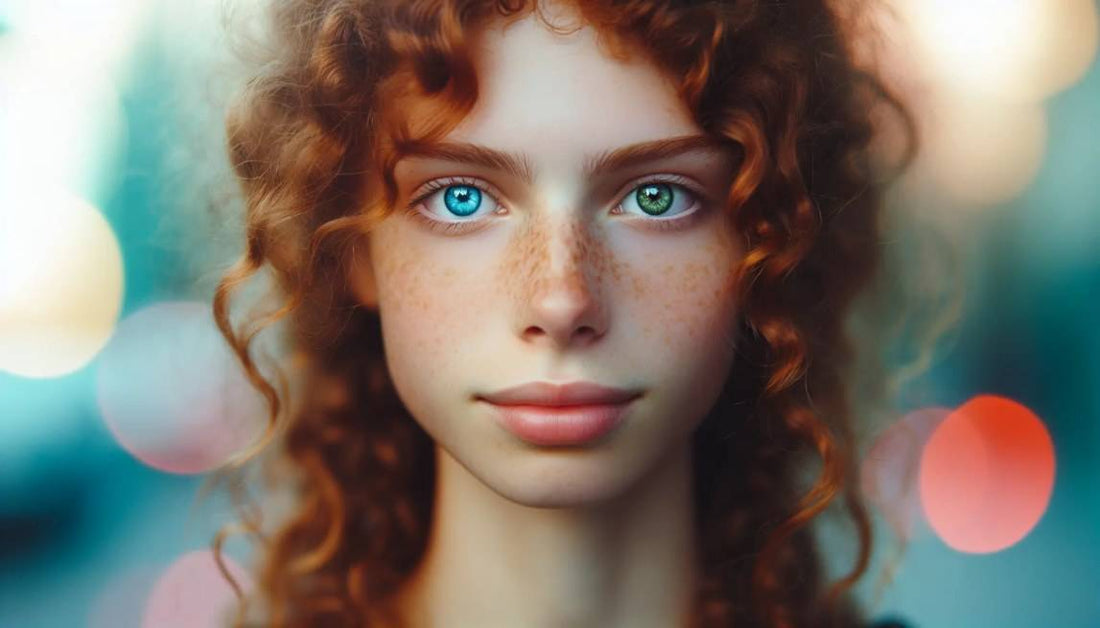
Discover the Most Unique Eye Colors in the Human Spectrum
Most Unique Eye Colors
10 min read • Posted on 7 February 2024 • Heba from Kraywoods
Are you intrigued by unique eye colors that defy familiar browns and blues? This article highlights the unique eye colors in human eyes, green, amber, gray, and hazel, and unpacks their genetic stories. Less than 5% of the global population boasts these rarest eye colors yet, and we're here to reveal why they're so extraordinary.
Key Takeaways
Human eye colors range from standard shades like brown to rare hues like green, amber, gray, and hazel, often due to complex genetic interactions and specific melanin concentrations.
The genetic basis of eye color involves multiple genes, notably OCA2 and HERC2 on chromosome 15, which determine melanin production and distribution, influencing the diverse spectrum of eye colors.
There are rare eye conditions like heterochromia, anisocoria, and albinism that cause unusual eye colors and appearances, usually due to genetic mutations affecting melanin production.
Diving into the World of Unique Eye Colors
One of the most fascinating features of our physical appearance is eye color. With a wide range from the most common eye color, brown to green, it is the rarest of shades like green, gray, or even violet and red; it not only adds aesthetic beauty but also showcases the complexity of genetics. Although brown eyes are prevalent globally, other hues, such as:
-
Green
-
Amber
-
Gray
They are less commonly seen yet intriguingly unique.
Each distinct shade has its own genetic story and stands out for being one among the world population with some scarce eye colors.
Approximately 2% of people across the globe possess emerald enigma-like "green" eyes.
Amber-colored ones with their golden glow are another rarity.
Gray-colored irises make an even rarer sight. Hazel-hued chameleons grace a few lucky individuals' gazes thanks to their elusive properties that cause them to tangle.
Green Eyes: The Emerald Enigma
Green eyes, often called emerald enigma, stand as some of nature's most captivating wonders. Their rarity, found in only about 2% of the world's population, adds to their mysterious allure. More common in Europe and among women, their enchanting hue results from the complex interplay of genetics and the scattering of light in the iris.
The mesmerizing green color in eyes results from a low to moderate presence of melanin influenced by genes associated with pigment production.
This balance of melanin, combined with the scattering of light in the iris, gives these eyes their distinctive emerald hue. The genetic factors influencing green eyes are complex, making them one of nature's most captivating mysteries.
Amber Eyes: The Golden Gleam
Amber red eyes. To a shining gold color, red eyes provide another fascinating exception in the wide range of human eye colors.
These eyes are genuinely striking and feature warm, golden shades ranging from a deep honey tone to a more coppery shade. This unique hue is only found in approximately 5% of the global population and is more frequently observed among animals than humans.
The distinctive golden tint in amber eyes results from pheomelanin of pheomelanin, a reddish-brown pigment responsible for determining hair and skin pigmentation.
When violet pigment is combined with light diffraction within the iris, this coloring creates an enchanting sparkle that sets these rare irises apart. The scarce occurrence and their captivating appearance make amber-colored eyes mesmerizing.
Gray Eyes: The Silvery Storm
Gray eyes, also known as silvery storm eyes, are a much less common occurrence than violet eyes in the human population and can be the rarest eye color found in only approximately 3% of people worldwide.
These unique eye color variations are often seen as variations of light blue eyes due to their high concentration of collagen fibers in the iris, giving them a silver tone. This particular shade is achieved through lower levels of melanin pigment in these individuals' irises and increased collagen at the front layer.
Interestingly, there can be significant variability within gray eye colors themselves. Darker shades may have slightly higher concentrations or amounts compared to lighter ones. The distinct appearance and rarity of standard eye colors make studying this diversity among human eye colors intriguing for researchers.
Besides adding aesthetic value to one's overall look or uniqueness, having gray-colored irises could affect how individuals perceive blue light since they have low levels. Overall, I think.
Gray-eyed humans provide insight into the complex nature of eye color and its origins from the interactions of melanin and collagen with our bodies. These likely continue to stimulate the interest of future studies related to human optics and help us better understand this fascinating aspect of our physical makeup.
Exploring the reciprocal relationship between light and sight through unique colors like these may deepen our knowledge of how we see and process visual information daily. Like blue eyes, the nuances found in gray irises can tell more.
Hazel Eyes: The Chameleon Charm
Hazel eyes, found in about 5% of the world's population, are a rare and intriguing eye color known for their chameleon-like qualities.
These uniquely colored eyes can shift from brown to violet or red to green, depending on lighting conditions. This is due to an uneven distribution of melanin in the iris that gives hazel eyes their distinctive appearance.
The mesmerizing allure of hazel eyes comes from its striking and unique combination of colors, typically varying shades or tints of light brown with specks or flecks ranging from green to gold.
While this variation can be seen in people with colored irises, it is most common among those hailing from North Africa, the Middle East, Brazil, and Spain, where these captivatingly colored orbs stand out even more against darker features.
As light hits them at different angles throughout the day, these special pairings possess a unique quality, making them appear to be changing hues while reflecting bright sunlight into our vision.
This uncommon occurrence caused by irregular amounts of pigment distributed within each orb adds intrigue again, pinpointing why many find themselves staring into someone's entrancing stare whenever meeting up close.
Blue Eyes: From Common to Uncommon Shades
Blue, the most common eye color in some populations, can range from the deepest sapphire to the palest ice blue. The rarity of blue eyes comes from the unique shades and patterns, with some individuals having strikingly light blue eyes. These variations in blue eye color can be attributed to genetics, with some families having a higher propensity for either lighter eyes or darker shades.
The Rarity of Light Brown Eyes
Light brown eyes, a common dark brown variation, sometimes appear almost amber or honey-colored. This variation in brown eyes, while not as rare as other colors, still the eyes appearance holds a unique beauty, especially when contrasted with lighter skin tones. The rarity of light brown eyes in specific populations adds to their appeal, making them a coveted feature in some cultures.
Genetics Behind Unique Eye Colors
The color of our eyes serves as proof of the complexity and diversity present in human biology. It is determined by a distinct blend and concentration of pigments found in the iris, primarily influenced by genetic factors related to pigment production. This amalgamation of genes results in a wide array of eye colors and contributes to the rarity of the peripheral shades.
This story about eye color cannot be attributed solely to one gene. Instead, it involves several genes working together. Factors such as different expressions and interactions among these genes are essential in creating the vast spectrum of hues observed in different human eyes.
We will delve more in-depth into the means behind eye coloring, such as the significance of melanin and how multiple genes collaborate for this process.
Melanin's Role in Eye Color
Melanin, a pigment accountable for skin coloring, hair, and eyes, is vital in determining eye color. The distribution and amount of melanin present in the iris (which is the colored part of the eye) impacts eye color percentages and both shade and hue variation within each person's eye tone, from high concentrations less melanin yielding dark brown eyes to lower levels resulting in light blue or green hues.
Interestingly enough, two types of Melanins exert different influences on determining eye color pigmentation: Eumelanin (a deep black-brown compound) determines darker shades like brown or even black, while pheomelanin (yellow-red pigment) affects lighter colors such as amber tones.
This interaction between these two classes results in endless combinations, resulting in all possible variations across human populations today.
Multiple Genes at Work
The color of our eyes is not solely determined by one gene but rather by a complex combination of up to 16 genes. The most influential players in this genetic process are OCA2 and HERC2, located on chromosome 15. While the OCA2 gene aids in producing melanin, the pigment responsible for eye, hair, and skin coloring, its function is greatly influenced by HERC2.
Along with these two essential genes, other factors contribute to humans' wide range of eye colors. Through their various expressions and interactions within the body's genetic makeup, the body has different genetic makeups.
Rare Eye Color Conditions
Some people have rare eye colors due to certain conditions. These conditions, like heterochromia, anisocoria, and albinism, can significantly alter the appearance of one's eyes. Although these occurrences are uncommon, they offer valuable insights into the varied and intricate nature of the ancient human genetics of eye color.
One such condition is heterochromia, which causes a person to have two different colored eyes. Anisocoria results in pupils that differ in size from each other. At the same time, albinism affects melanin production in skin, hair, and the eyes, causing lighter or even reddish, pink, or purple hues due to a lack of pigment and visible blood vessels.
We will delve deeper into these exciting conditions later on.
Heterochromia: A Tale of Two Colors
Heterochromia is a unique condition where an individual has two different eye colors in one iris. This uncommon occurrence results from varying melanin levels in each iris, creating an intriguing visual contrast with colored eyes. There are three types of heterochromia: complete, central, and sectoral.
While uncommon, heterochromia is typically harmless and does not require treatment. If the condition suddenly appears during adulthood, it could indicate underlying health issues such as vision problems, eye injuries, or infections that may need medical attention to be appropriately addressed.
Anisocoria: Unequal Pupils
Anisocoria is a captivating eye disorder characterized by unequal pupil sizes. While it may seem similar to heterochromia, this scarce condition affects the pupils rather than the iris. It can be current from childbirth or afterward in life due to particular factors or injuries.
Anisocoria does not require treatment unless there is an underlying health problem causing it. If you notice a sudden change in the color of your eyes or pupil size, it's essential to consult with an eye doctor as soon as possible. Although harmless on its own, the abrupt onset of anisocoria could indicate more severe conditions, such as glaucoma or nerve damage, that need medical attention.
Albinism: The Light Spectrum
Albinism is a genetic ailment that influences the exhibition of melanin, the dye that gives color to our skin, hair, and eyes. This genetic mutation results in:
various shades of light eye colors
In some instances, due to visible blood vessels in their iris, individuals with albinism may have red, pink, or violet eyes.
Although it only impacts a small percentage of people globally,binism can significantly affect an individual's vision. The lack of pigmentation often leads to issues such as reduced clarity, difficulty tolerating bright lights, and involuntary movements of the eyeballs.
However, this does not hinder those with this condition from living fulfilling lives. Instead, it adds diversity through its unique eye colors, revealing another aspect that makes us human.
Eye Color and Health Connections
The color of our eyes is a notable feature beyond aesthetic appeal. According to research, there may be a correlation between eye color and potential health risks or benefits.
For instance, individuals with lighter eye colors might have an elevated chance of conditions like macular degeneration and ocular cancer. In contrast, darker eyes could provide added protection due to more melanin.
Surprisingly, a recent study found that women with light-colored eyes showed greater pain tolerance during childbirth than those with dark iris. It should be noted that various factors contribute to personal health outcomes, and eye color is just one factor among many. Maintaining good vision includes regular check-ups as well as leading a healthy lifestyle.
Enhancing Your Unique Eye Color
Understanding the science and genetics behind standard eye color may inspire you to find ways to enhance your unique features. Regardless of whether you have familiar brown or rare green eyes, there are simple tricks that can make them stand out even more.
From selecting suitable eyewear and makeup shades to wearing complementary clothing colors, it is possible to amplify the natural beauty of different eye colors.
For those with green eyes, warm hues like gold or brown in frame choices can bring out their richness. On the other hand, Amber eyes produce brown eyes that can benefit from contrasting frames such as black or navy blue for added emphasis.
When it comes to hazel eyes specifically, though matching outfits won't necessarily impact their appearance positively, specific colors worn close enough certainly will.
Makeup also plays a significant role in enhancing one's eye color. Choosing golden and bronze tones for eyeshadow applications makes amber-colored ones appear brighter and more profound.
The Science Behind Changing Eye Colors
Although our eye color is determined at birth, advancements in science and technology have made it possible to change the natural hue of our eyes. Techniques such as using colored contact lenses or undergoing laser procedures or iris implants are available for altering eye color. Each method has potential risks and benefits that should be carefully considered.
The most commonly used and safest approach for changing eye color is colored contact lenses, which offer various shades. It is recommended to seek guidance from an optometrist before wearing contacts to ensure they will not harm your eyes.
More invasive methods like laser treatment or insertion of artificial irises carry specific health hazards and are only approved for medical purposes in select countries.
Summary
The wide range of eye colors, from ordinary browns to rare greens, and the unique genetic condition of heterochromia reflect our complex genetic makeup as humans. Beyond its captivating nature, eye color offers insights into genetics, overall health, and individual style.
Our eyes remind us that our differences make us unique and should be embraced. Whether your irises showcase shades of brown or blue with speckles of green in between, they add to your distinctive identity.
Frequently Asked Questions
What is the most stunning and irregular eye color?
The scarcity of melanin in the eyes creates a unique Rayleigh scattering light-reflecting effect, making green often considered the rarest eye color. This is due to its ability to reflect and scatter light differently than other colors.
Which eye color is most attractive?
The preference for eye color varies among individuals, with men being drawn to gray, blue, and green eyes, while women tend to favor green, hazel, and gray. Surprisingly, though, the results were surprising.
A vast majority of 79% of the world's population has brown eyes.
This exciting fact remains despite the popularity of shades such as green or gray, which are often deemed more attractive by different genders. Blue is also a sought-after eye color by some people.
Are turquoise eyes natural?
Indeed, an individual can have turquoise eyes, which is remarkable because of the unique mixture of blue, yellow, and green hues with a touch of brown pigment in their iris.
What determines a person's eye color?
Eye color is defined by the engagement and combination of pigments in a person's iris, primarily influenced by genetic factors related to pigment production. Genes have a substantial impact on determining an individual's unique eye color.
Can amber eyes be enhanced with makeup?
Gold and bronze eyeshadow shades are highly recommended to enhance the beauty of amber eyes. These colors perfectly complement amber eyes' rich depth and vibrancy, making them appear even more prominent.








